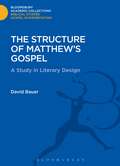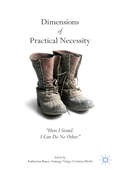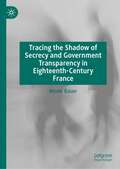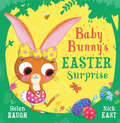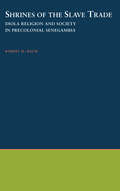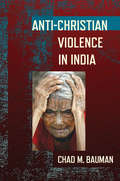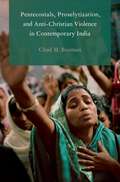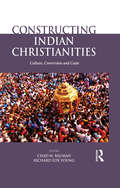- Table View
- List View
Gott, Gaia und eine neue Gesellschaft: Theologie anders denken mit Bruno Latour (Religionswissenschaft #28)
by Christian Bauer Daniel Bogner Michael SchüßlerWie lesen und deuten wir die Welt, in der wir leben? Wer ist der Mensch in Relation zu Natur und Technik? Welche Pointe liegt in den Selbstzuschreibungen »religiös« oder »gläubig«? Mit der Akteur-Netzwerk-Theorie und einer Auflösung der klassischen Gegenüberstellung von Natur und Kultur ist das Denken Bruno Latours zu einer gefragten Ressource in gegenwärtigen Debatten geworden. Die Beiträger*innen des Bandes gehen seinem Anspruch nach, eine »symmetrische« Anthropologie zu entwerfen, in der Materiellem ein mitentscheidender Platz für die Theorie-, Wert- und Urteilsbildung zukommt — denn dieses Denken gibt auch der Theologie wertvolle Impulse für ihre intellektuelle Zeitgenossenschaft.
The Structure of Matthew's Gospel: A Study in Literary Design (The Library of New Testament Studies)
by David BauerThis book addresses a central issue confronting the reader of the Gospel. Professor Bauer describes the impasse that has been reached in recent investigation of the structure of Matthew and demonstrates that an appreciation of literary design can provide a way forward. After identifying rhetorical features that relate to literary structure, he devotes the major part of his book to a systematic examination of such features as they appear in the Gospel in order to gain a fresh insight into the shape of the work. This study is valuable both for its comprehensive and judicious review of the question of structure in Matthew's Gospel and for the new direction which it establishes.
Haarige Kunst: Über den Eigensinn des Haars und das Können von Friseuren
by Hans G. Bauer Fritz BöhleIm Mittelpunkt dieses Buches steht ein ‚Gegenstand‘, mit dem wir alle tagtäglich zu tun haben: das lebendige, so eigenwillige Haar. Jede und jeder von uns besitzt Erfahrungen mit seinem Haar, seinen Frisuren und Friseuren, ist von diesem Thema also unmittelbar betroffen und berührt.Die Autoren gehen der Frage nach, was einen ‚guten‘ Friseur ausmacht und beleuchten wenig bekannte und überraschende Seiten eines alten Berufs mit wechselhafter Geschichte und neuen Herausforderungen. Die genaue Betrachtung und Beschreibung der Arbeit des Friseurs ist in diesem Buch eingebettet in eine kulturhistorische Betrachtung der Bedeutung der Haare, der Entwicklung des Friseurberufs und in soziodemografische Daten und Einschätzungen zur aktuellen Lage des Friseurhandwerks.
Dimensions of Practical Necessity: “Here I Stand. I Can Do No Other."
by Katharina Bauer Somogy Varga Corinna MiethThis collection of essays provides the first systematic investigation of practical necessity and offers novel perspectives on this intriguing phenomenon. While debates on necessity often take place in the realm of metaphysics, there is a form of necessity that is pertinent to practical philosophy. “Here I stand. I can do no other,” a phrase habitually attributed to Martin Luther, is often interpreted as revealing underlying normative reasons that exhibit a special kind of necessitating force, experienced as an inescapable constraint by the agent. However, one of the features that make this phenomenon so fascinating is that this constraint is often deciphered as stemming from a form of necessitation that articulates the agent’s autonomy or practical identity. Luther’s saying serves as a leitmotif for an exploration of different claims and challenges related to practical necessity. As the complex philosophical investigations are based on familiar, everyday experiences the book is accessible to any academic readership.
Dimensions of Practical Necessity: “Here I Stand. I Can Do No Other."
by Katharina Bauer Somogy Varga Corinna MiethThis collection of essays provides the first systematic investigation of practical necessity and offers novel perspectives on this intriguing phenomenon. While debates on necessity often take place in the realm of metaphysics, there is a form of necessity that is pertinent to practical philosophy. “Here I stand. I can do no other,” a phrase habitually attributed to Martin Luther, is often interpreted as revealing underlying normative reasons that exhibit a special kind of necessitating force, experienced as an inescapable constraint by the agent. However, one of the features that make this phenomenon so fascinating is that this constraint is often deciphered as stemming from a form of necessitation that articulates the agent’s autonomy or practical identity. Luther’s saying serves as a leitmotif for an exploration of different claims and challenges related to practical necessity. As the complex philosophical investigations are based on familiar, everyday experiences the book is accessible to any academic readership.
Tracing the Shadow of Secrecy and Government Transparency in Eighteenth-Century France
by Nicole BauerThis book traces changing attitudes towards secrecy in eighteenth-century France, and explores the cultural origins of ideas surrounding government transparency. The idea of keeping secrets, both on the part of individuals and on the part of governments, came to be viewed with more suspicion as the century progressed. By the eve of the French Revolution, writers voicing concerns about corruption saw secrecy as part and parcel of despotism, and this shift went hand in hand with the rise of the idea of transparency. The author argues that the emphasis placed on government transparency, especially the mania for transparency that dominated the French Revolution, resulted from the surprising connections and confluence of changing attitudes towards honour, religious movements, rising nationalism, literature, and police practices. Exploring religious ideas that associated secrecy with darkness and wickedness, and proto-nationalist discourse that equated foreignness with secrecy, this book demonstrates how cultural shifts in eighteenth-century France influenced its politics. Covering the period of intense fear during the French Revolution and the paranoia of the Reign of Terror, the book highlights the complex interplay of culture and politics and provides insights into our attitudes towards secrecy today.
Kabbala und religiöse Identität: Eine religionswissenschaftliche Analyse des deutschsprachigen Kabbalah Centre (Religionswissenschaft #7)
by Nicole Maria BauerTrotz fortschreitender Säkularisierung sind neue religiöse Gruppen sehr erfolgreich und ziehen durch verschiedene Marketing-Strategien jährlich hunderte von Menschen an. Was genau macht ihre Attraktion aus? Eine Antwort darauf gibt Nicole Maria Bauers religionswissenschaftliche Analyse des »Kabbalah Centre«, einer Ende der 1960er Jahre in den USA gegründeten neureligiösen Bewegung, die seit einigen Jahren auch in Deutschland vertreten ist und der sich Menschen aus unterschiedlichen religiösen Kontexten anschließen. Die transdisziplinäre Studie beleuchtet die Konstruktion religiöser Identität auf institutioneller und personaler Ebene und entwirft einen neuen Ansatz für deren Untersuchung. Dabei werden auch aktuelle Trends wie etwa die Frage nach »Religious Branding« aufgegriffen und mit neueren Ansätzen aus der Identitätsforschung verknüpft.
The Art of the Public Grovel: Sexual Sin and Public Confession in America
by Susan Wise BauerWhether you are a politician caught carrying on with an intern or a minister photographed with a prostitute, discovery does not necessarily spell the end of your public career. Admit your sins carefully, using the essential elements of an evangelical confession identified by Susan Wise Bauer in The Art of the Public Grovel, and you, like Bill Clinton, just might survive. In this fascinating and important history of public confession in modern America, Bauer explains why and how a type of confession that first arose among nineteenth-century evangelicals has today become the required form for any successful public admission of wrongdoing--even when the wrongdoer has no connection with evangelicalism and the context is thoroughly secular. She shows how Protestant revivalism, group psychotherapy, and the advent of talk TV combined to turn evangelical-style confession into a mainstream secular rite. Those who master the form--Bill Clinton, Jimmy Swaggart, David Vitter, and Ted Haggard--have a chance of surviving and even thriving, while those who don't--Ted Kennedy, Jim Bakker, Cardinal Bernard Law, Mark Foley, and Eliot Spitzer--will never really recover. Revealing the rhetoric, theology, and history that lie behind every successful public plea for forgiveness, The Art of the Public Grovel will interest anyone who has ever wondered why Clinton is still popular while Bakker fell out of public view, Ted Kennedy never got to be president, and Law moved to Rome.
The Art of the Public Grovel: Sexual Sin and Public Confession in America
by Susan Wise BauerWhether you are a politician caught carrying on with an intern or a minister photographed with a prostitute, discovery does not necessarily spell the end of your public career. Admit your sins carefully, using the essential elements of an evangelical confession identified by Susan Wise Bauer in The Art of the Public Grovel, and you, like Bill Clinton, just might survive. In this fascinating and important history of public confession in modern America, Bauer explains why and how a type of confession that first arose among nineteenth-century evangelicals has today become the required form for any successful public admission of wrongdoing--even when the wrongdoer has no connection with evangelicalism and the context is thoroughly secular. She shows how Protestant revivalism, group psychotherapy, and the advent of talk TV combined to turn evangelical-style confession into a mainstream secular rite. Those who master the form--Bill Clinton, Jimmy Swaggart, David Vitter, and Ted Haggard--have a chance of surviving and even thriving, while those who don't--Ted Kennedy, Jim Bakker, Cardinal Bernard Law, Mark Foley, and Eliot Spitzer--will never really recover. Revealing the rhetoric, theology, and history that lie behind every successful public plea for forgiveness, The Art of the Public Grovel will interest anyone who has ever wondered why Clinton is still popular while Bakker fell out of public view, Ted Kennedy never got to be president, and Law moved to Rome.
The Art of the Public Grovel: Sexual Sin and Public Confession in America
by Susan Wise BauerWhether you are a politician caught carrying on with an intern or a minister photographed with a prostitute, discovery does not necessarily spell the end of your public career. Admit your sins carefully, using the essential elements of an evangelical confession identified by Susan Wise Bauer in The Art of the Public Grovel, and you, like Bill Clinton, just might survive. In this fascinating and important history of public confession in modern America, Bauer explains why and how a type of confession that first arose among nineteenth-century evangelicals has today become the required form for any successful public admission of wrongdoing--even when the wrongdoer has no connection with evangelicalism and the context is thoroughly secular. She shows how Protestant revivalism, group psychotherapy, and the advent of talk TV combined to turn evangelical-style confession into a mainstream secular rite. Those who master the form--Bill Clinton, Jimmy Swaggart, David Vitter, and Ted Haggard--have a chance of surviving and even thriving, while those who don't--Ted Kennedy, Jim Bakker, Cardinal Bernard Law, Mark Foley, and Eliot Spitzer--will never really recover. Revealing the rhetoric, theology, and history that lie behind every successful public plea for forgiveness, The Art of the Public Grovel will interest anyone who has ever wondered why Clinton is still popular while Bakker fell out of public view, Ted Kennedy never got to be president, and Law moved to Rome.
A Greek-English Lexicon of the New Testament and Other Early Christian Literature
by Walter BauerDescribed as an "invaluable reference work" (Classical Philology) and "a tool indispensable for the study of early Christian literature" (Religious Studies Review) in its previous edition, this new updated American edition of Walter Bauer's Wörterbuch zu den Schriften des Neuen Testaments builds on its predecessor's staggering deposit of extraordinary erudition relating to Greek literature from all periods. Including entries for many more words, the new edition also lists more than 25,000 additional references to classical, intertestamental, Early Christian, and modern literature. In this edition, Frederick W. Danker's broad knowledge of Greco-Roman literature, as well as papyri and epigraphs, provides a more panoramic view of the world of Jesus and the New Testament. Danker has also introduced a more consistent mode of reference citation, and has provided a composite list of abbreviations to facilitate easy access to this wealth of information. Perhaps the single most important lexical innovation of Danker's edition is its inclusion of extended definitions for Greek terms. For instance, a key meaning of "episkopos" was defined in the second American edition as overseer; Danker defines it as "one who has the responsibility of safeguarding or seeing to it that something is done in the correct way, guardian." Such extended definitions give a fuller sense of the word in question, which will help avoid both anachronisms and confusion among users of the lexicon who may not be native speakers of English. Danker's edition of Bauer's Wörterbuch will be an indispensable guide for Biblical and classical scholars, ministers, seminarians, and translators.
A Greek-English Lexicon of the New Testament and Other Early Christian Literature
by Walter BauerDescribed as an "invaluable reference work" (Classical Philology) and "a tool indispensable for the study of early Christian literature" (Religious Studies Review) in its previous edition, this new updated American edition of Walter Bauer's Wörterbuch zu den Schriften des Neuen Testaments builds on its predecessor's staggering deposit of extraordinary erudition relating to Greek literature from all periods. Including entries for many more words, the new edition also lists more than 25,000 additional references to classical, intertestamental, Early Christian, and modern literature. In this edition, Frederick W. Danker's broad knowledge of Greco-Roman literature, as well as papyri and epigraphs, provides a more panoramic view of the world of Jesus and the New Testament. Danker has also introduced a more consistent mode of reference citation, and has provided a composite list of abbreviations to facilitate easy access to this wealth of information. Perhaps the single most important lexical innovation of Danker's edition is its inclusion of extended definitions for Greek terms. For instance, a key meaning of "episkopos" was defined in the second American edition as overseer; Danker defines it as "one who has the responsibility of safeguarding or seeing to it that something is done in the correct way, guardian." Such extended definitions give a fuller sense of the word in question, which will help avoid both anachronisms and confusion among users of the lexicon who may not be native speakers of English. Danker's edition of Bauer's Wörterbuch will be an indispensable guide for Biblical and classical scholars, ministers, seminarians, and translators.
Catholic Theology: An Introduction
by Frederick C. Bauerschmidt James J. BuckleyIntroduction to Catholic Theology is an accessible but in-depth examination of the ways in which Catholic theology is rooted in and informs Catholic practice. Weaves together discussion of the Bible, historical texts, reflections by important theologians, and contemporary debates for a nuanced look at belief and practice within the Catholic faith Provides an overview of all major theological areas, including scriptural, historical, philosophical, systematic, liturgical, and moral theology Appropriate for students at all levels, assuming no prior knowledge yet providing enough insight and substance to interest those more familiar with the topic Written in a dynamic, engaging style by two professors with more than 50 years of classroom experience between them
Catholic Theology: An Introduction
by Frederick C. Bauerschmidt James J. BuckleyIntroduction to Catholic Theology is an accessible but in-depth examination of the ways in which Catholic theology is rooted in and informs Catholic practice. Weaves together discussion of the Bible, historical texts, reflections by important theologians, and contemporary debates for a nuanced look at belief and practice within the Catholic faith Provides an overview of all major theological areas, including scriptural, historical, philosophical, systematic, liturgical, and moral theology Appropriate for students at all levels, assuming no prior knowledge yet providing enough insight and substance to interest those more familiar with the topic Written in a dynamic, engaging style by two professors with more than 50 years of classroom experience between them
The Wiley Blackwell Companion to Catholicism (Wiley Blackwell Companions to Religion)
by Frederick C. Bauerschmidt James J. Buckley Jennifer Newsome Martin Trent PomplunProvides a broad and deep survey of Roman Catholic life and thought, updated and expanded throughout The Wiley Blackwell Companion to Catholicism provides an authoritative overview of the history, doctrine, practices, and expansion of Catholicism. Written by a group of distinguished scholars, this comprehensive reference work offers an illuminating account of the global, historical, and cultural phenomena of Catholicism. Accessible chapters address central topics in the practice of Catholic theology and the development of doctrine, including God and Jesus Christ, creation and Church, the Virgin Mary, the sacraments, moral theology, eschatology, and more. Throughout the text, the authors illustrate the unity and diversity of Catholic life and thought while highlighting the ways Catholicism overlaps with, and transforms, other ways of living and thinking. Now in its second edition, The Wiley Blackwell Companion to Catholicism is fully updated to include recent developments in the study of Catholicism. Extensively revised and expanded chapters, many of which written by new authors, address contemporary issues such as theology and politics, environmentalism, and the clerical sexual abuse crisis. Entirely new chapters cover the early modern Church, the Bible in Catholic theology, the Eastern Catholic churches, liturgy, care for creation, the consecrated life, challenges for the Catholic Church, and more. An informed and engaging intellectual journey through the past and present of Roman Catholicism, The Wiley Blackwell Companion to Catholicism: Illustrates the diversity of modern Catholic life and thought Describes Catholics in different lands, including the Holy Land, India, Africa, Europe, the British Isles, Asia, Oceania, and the Americas Surveys spirituality and ecumenism, inter-religious dialog, Catholic schools and hospitals, art and the sciences, the Holy See, and other central Catholic institutions and practices Covers major eras in Catholic history, from the Scriptures and the early Church to Post-Modernity Features new material on diverse practices of Catholicism across cultures, the global dimensions of the Catholic Church, race and ethnicity, and Eastern Catholic ChurchesThe Wiley Blackwell Companion to Catholicism, Second Edition, is the ideal textbook for surveys classes on Catholicism and Catholic theology in Catholic, Protestant, and non-confessional colleges and universities. It is also an invaluable resource for scholars and general readers interested in broadening their knowledge of Catholicism.
The Wiley Blackwell Companion to Catholicism (Wiley Blackwell Companions to Religion)
by Frederick C. Bauerschmidt James J. Buckley Jennifer Newsome Martin Trent PomplunProvides a broad and deep survey of Roman Catholic life and thought, updated and expanded throughout The Wiley Blackwell Companion to Catholicism provides an authoritative overview of the history, doctrine, practices, and expansion of Catholicism. Written by a group of distinguished scholars, this comprehensive reference work offers an illuminating account of the global, historical, and cultural phenomena of Catholicism. Accessible chapters address central topics in the practice of Catholic theology and the development of doctrine, including God and Jesus Christ, creation and Church, the Virgin Mary, the sacraments, moral theology, eschatology, and more. Throughout the text, the authors illustrate the unity and diversity of Catholic life and thought while highlighting the ways Catholicism overlaps with, and transforms, other ways of living and thinking. Now in its second edition, The Wiley Blackwell Companion to Catholicism is fully updated to include recent developments in the study of Catholicism. Extensively revised and expanded chapters, many of which written by new authors, address contemporary issues such as theology and politics, environmentalism, and the clerical sexual abuse crisis. Entirely new chapters cover the early modern Church, the Bible in Catholic theology, the Eastern Catholic churches, liturgy, care for creation, the consecrated life, challenges for the Catholic Church, and more. An informed and engaging intellectual journey through the past and present of Roman Catholicism, The Wiley Blackwell Companion to Catholicism: Illustrates the diversity of modern Catholic life and thought Describes Catholics in different lands, including the Holy Land, India, Africa, Europe, the British Isles, Asia, Oceania, and the Americas Surveys spirituality and ecumenism, inter-religious dialog, Catholic schools and hospitals, art and the sciences, the Holy See, and other central Catholic institutions and practices Covers major eras in Catholic history, from the Scriptures and the early Church to Post-Modernity Features new material on diverse practices of Catholicism across cultures, the global dimensions of the Catholic Church, race and ethnicity, and Eastern Catholic ChurchesThe Wiley Blackwell Companion to Catholicism, Second Edition, is the ideal textbook for surveys classes on Catholicism and Catholic theology in Catholic, Protestant, and non-confessional colleges and universities. It is also an invaluable resource for scholars and general readers interested in broadening their knowledge of Catholicism.
Baby Bunny’s Easter Surprise
by Helen BaughAn irresistible picture book about a very cheeky baby bunny!
Compassion and Solidarity: The Church for Others (The CBC Massey Lectures)
by Gregory BaumIn the forthright style that has earned him a reputation for controversy, theologian Gregory Baum presents the Faith and Justice movement in the churches -- especially the Roman Catholic Church -- together with the considerable opposition to it. He discusses why many Christians are becoming activists, turning their faith into deeds by working for the liberation of the poor, not only in South America and the Third World but in Canada, as well. Baum argues for a new ecumenism, permitting a more representative opinion within the Church and, in a larger sense, for what he believes are the fundamentals of a "just society." He says that there is a new realization that God is on the side of the oppressed -- that Christians are here to help in the struggle for liberation.
The Twentieth Century: A Theological Overview
by Gregory Baum"Many of the essays are well worth reading, particularly for those with interests in recent historical theology, church history and the sociology of religion." -- Oliver D. Crisp, Themelios 26.1 (Autumn 2001)
Shrines of the Slave Trade: Diola Religion and Society in Precolonial Senegambia
by Robert M. BaumIn this groundbreaking work, Robert Baum seeks to reconstruct the religious and social history of the Diola communities in southern Senegal during the precolonial era, when the Atlantic slave trade was at its height. Baum shows that Diola community leaders used a complex of religious shrines and priesthoods to regulate and contain the influence of the slave trade. He demonstrates how this close involvement with the traders significantly changed Diola religious life.
Anti-Christian Violence in India (Religion and Conflict)
by Chad M. BaumanDoes religion cause violent conflict, asks Chad M. Bauman, and if so, does it cause conflict more than other social identities? Through an extended history of Christian-Hindu relations, with particular attention to the 2007–2008 riots in Kandhamal, Odisha, Anti-Christian Violence in India examines religious violence and how it pertains to broader aspects of humanity. Is "religious" conflict sui generis, or is it merely one species of intergroup conflict? Why and how might violence become an attractive option for religious actors? What explains the increase in religious violence over the last twenty to thirty years?Integrating theories of anti-Christian violence focused on politics, economics, and proselytization, Anti-Christian Violence in India additionally weaves in recent theory about globalization and, in particular, the forms of resistance against Western secular modernity that globalization periodically helps to provoke. With such theories in mind, Bauman explores the nature of anti-Christian violence in India, contending that resistance to secular modernities is, in fact, an important but often overlooked reason behind Hindu attacks on Christians. Intensifying the widespread Hindu tendency to think of religion in ethnic rather than universal terms, the ideology of Hindutva, or "Hinduness," explicitly rejects both the secular privatization of religion and the separability of religions from the communities that incubate them. And so, with provocative and original analysis, Bauman questions whether anti-Christian violence in contemporary India is really about religion, in the narrowest sense, or rather a manifestation of broader concerns among some Hindus about the Western sociopolitical order with which they associate global Christianity.
PENT PROS & ANTI-CHRIST VIOL CONT IND C (Global Pentecostalism and Charismatic Christianity)
by Chad M. BaumanEvery year, there are several hundred attacks on India's Christians. These attacks are carried out by violent anti-minority activists, many of them provoked by what they perceive to be a Christian propensity for aggressive proselytization, or by rumored or real conversions to the faith. Pentecostals are disproportionately targeted. Drawing on extensive interviews, ethnographic work, and a vast scholarly literature on interreligious violence, Hindu nationalism, and Christianity in India, Chad Bauman examines this phenomenon. While some of the factors in the targeting of Pentecostals are obvious and expected-their relatively greater evangelical assertiveness, for instance-other significant factors are less acknowledged and more surprising: marginalization of Pentecostals by "mainstream" Christians, the social location of Pentecostal Christians, and transnational flows of missionary personnel, theories, and funds. A detailed analysis of Indian Christian history, contemporary Indian politics, Indian social and cultural characteristics, and Pentecostal belief and practice, this volume sheds important light on a troubling fact of contemporary Indian life.
Pentecostals, Proselytization, and Anti-Christian Violence in Contemporary India (Global Pentecostalism and Charismatic Christianity)
by Chad M. BaumanEvery year, there are several hundred attacks on India's Christians. These attacks are carried out by violent anti-minority activists, many of them provoked by what they perceive to be a Christian propensity for aggressive proselytization, or by rumored or real conversions to the faith. Pentecostals are disproportionately targeted. Drawing on extensive interviews, ethnographic work, and a vast scholarly literature on interreligious violence, Hindu nationalism, and Christianity in India, Chad Bauman examines this phenomenon. While some of the factors in the targeting of Pentecostals are obvious and expected-their relatively greater evangelical assertiveness, for instance-other significant factors are less acknowledged and more surprising: marginalization of Pentecostals by "mainstream" Christians, the social location of Pentecostal Christians, and transnational flows of missionary personnel, theories, and funds. A detailed analysis of Indian Christian history, contemporary Indian politics, Indian social and cultural characteristics, and Pentecostal belief and practice, this volume sheds important light on a troubling fact of contemporary Indian life.
Constructing Indian Christianities: Culture, Conversion and Caste
by Chad M. Bauman Richard Fox YoungThis volume offers insights into the current ‘public-square’ debates on Indian Christianity. Drawing on ethnographic fieldwork as well as rigorous analyses, it discusses the myriad histories of Christianity in India, its everyday practice and contestations and the process of its indigenisation. It addresses complex and pertinent themes such as Dalit Indian Christianity, diasporic nationalism and conversion. The work will interest scholars and researchers of religious studies, Dalit and subaltern studies, modern Indian history, and politics.
Constructing Indian Christianities: Culture, Conversion and Caste
by Chad M. Bauman Richard Fox YoungThis volume offers insights into the current ‘public-square’ debates on Indian Christianity. Drawing on ethnographic fieldwork as well as rigorous analyses, it discusses the myriad histories of Christianity in India, its everyday practice and contestations and the process of its indigenisation. It addresses complex and pertinent themes such as Dalit Indian Christianity, diasporic nationalism and conversion. The work will interest scholars and researchers of religious studies, Dalit and subaltern studies, modern Indian history, and politics.

